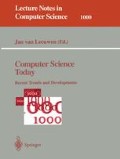Abstract
The practice of parallel computing seems to be in a crisis. Parallel computing has not become a common matter as it was expected some time ago. Some people are up in arms accusing computer science for not being sufficiently prepared for the advent of parallel computing and for not offering immediate remedies for the current situation. The present paper tries to recapitulate the relevant developments within the field of abstract parallel machine models by explaining its motivations, achievements and recent trends. We see a continuous interplay between the internal needs of the theory and the response to technological achievements. The parallel computing crisis and possible ways to resolve it are explained.
This research was supported by GA čR Grant No. 201/95/0976 “Hypercomplex.”
Preview
Unable to display preview. Download preview PDF.
References
Adler, M., Byers, J. W., Karp, R. M.: Scheduling Parallel Communication: The hrelation problem. In: J. Wiedermann, P. Hájek (Eds.), Mathematical Foundations of Computer Science 1995, 20th Int. Symposium (MFCS'95), Lecture Notes in Computer Science, Vol. 969, Springer-Verlag, Berlin, 1995, pp. 1–20.
Bilardi, G., Preparata, F. P.: Horizons of Parallel Computing. TR No. CS-93-20, Dept of Computer Science, Universita di Padova, May 1993.
Birge, R.R.: Protein-Based Computers. Scientific American, March 1995, pp. 66–71.
Brassard, G.: A Quantum Jump in Computer Science. This volume.
Chazelle, B., Monier, L.: A Model of Computation for VLSI with Related Complexity Results. JACM 32 (1985) 573–588.
Chlebus, B. S., Czumaj, A., Gasieniec, L., Kowaluk, M., Plandowski, W.: Parallel Alternating-Direction Access Machine. Proceedings of Abstracts of ALTEC IV International Workshop, Charles University, Prague, March 1995.
Culler, D., Karp, R., Patterson, D., Sahay, A., Schauser, K.E., Santos, E., Subramonian, R., von Eicken, T.: LogP: Towards a Realistic Model of Parallel Computation. In: Proc. 4th Annual ACM Symposium on Principles and Practice of Parallel Programming (PPOPP'93), May 1993, California, USA.
Feldman, Y., Shapiro, E.: Spatial Machines: a More Realistic Approach to Parallel Computing. CACM 35:10 (1992) 61–73.
Furht, B.: Parallel Computing: Glory and Collapse. COMPUTER, November 1994, pp. 74–75.
Johnson, D.S.: A Catalog of Complexity Classes. In: J. van Leeuwen (Ed.), Handbook of Theoretical Computer Science, Vol. A, Elsevier Science Publishers, Amsterdam, 1990, pp. 67–161.
Karp, R.M., Ramachandran, V.: Parallel Algorithms for Shared-Memory Machines. In: J. van Leeuwen (Ed.), Handbook of Theoretical Computer Science, Vol. A, Elsevier Science Publishers, Amsterdam, 1990, pp. 869–941.
Mead, C., Conway, L.: Introduction to VLSI Systems. Addison-Wesley Publ. Comp., Reading, MA, 1980.
Papadimitriou, Ch. H.: Computational Complexity. Addison-Wesley Publ. Comp., Reading, MA, 1994.
Pietracaprina, A., Pucci, G., Sibeyn, J.F.: Constructive Deterministic PRAM Simulation on a Mesh-Connected Computer. TR-93-059, International Computer Science Institute, Berkeley, CA, Oct. 1993.
Sibeyn, J.F., Kaufmann, M.: Solving Cheap Graph Problems on Meshes. In: J. Wiedermann, P. Hájek (Eds.), Mathematical Foundations of Computer Science 1995, 20th Int. Symposium (MFCS'95), Lecture Notes in Computer Science, Vol. 969, Springer-Verlag, Berlin, 1995, pp. 412–422.
Siegelmann, H.T.: Recurrent Neural Networks. This volume.
Valiant, L.G.: A Bridging Model for Parallel Computation. CACM 33:8 (1990) 103–111.
Valiant, L.G.: General Purpose Parallel Architectures. In: J. van Leeuwen (Ed.), Handbook of Theoretical Computer Science, Vol. A, Elsevier Science Publishers, Amsterdam, 1990, pp. 943–971.
van Emde Boas, P.: Machine Models and Simulations. In: J. van Leeuwen (Ed.), Handbook of Theoretical Computer Science, Vol. A, Elsevier Science Publishers, Amsterdam, 1990, pp. 1–66.
van Leeuwen, J., Wiedermann, J.: Array Processing Machines: An Abstract Model. BIT 27 (1987) 25–43.
Vitányi, P.: Locality, Communication, and Interconnect Length in Multicomputers. SIAM J. Comput. 17:4 (1988) 659–672.
Vitányi, P.: Multiprocessor Architectures and Physical Laws. In: Proc. PhysComp94, IEEE Computer Society Press, 1994.
Vitányi, P.: Physics and the New Computation. In: J. Wiedermann, P. Hájek (Eds.), Mathematical Foundations of Computer Science 1995, 20th Int. Symposium (MFCS'95), Lecture Notes in Computer Science, Vol. 969, Springer-Verlag, Berlin, 1995, pp. 106–128.
Wiedermann, J.: Parallel Turing Machines. Tech. Rep. RUU-CS-84-11, Dept. of Computer Science, Utrecht University, Utrecht, 1984.
Wiedermann, J.: Weak Parallel Machines: A New Class of Physically Feasible Parallel Machine Models. In: I.M. Havel, V. Koubek (Eds.), Mathematical Foundations of Computer Science 1992, 17th Int. Symposium (MFCS'92), Lecture Notes in Computer Science, Vol. 629 Springer Verlag, Berlin, 1992, pp. 95–111.
Wiedermann, J.: Fast Sequential and Parallel Simulation of Nondeterministic Computations. Computers and Artificial Intelligence 13:6 (1994) 521–536.
Wiedermann, J.: Five New Simulation Results on Turing Machines. Technical Report V-631, Institute of Computer Science, Prague, 1995.
Author information
Authors and Affiliations
Editor information
Rights and permissions
Copyright information
© 1995 Springer-Verlag Berlin Heidelberg
About this chapter
Cite this chapter
Wiedermann, J. (1995). Quo vadetis, parallel machine models?. In: van Leeuwen, J. (eds) Computer Science Today. Lecture Notes in Computer Science, vol 1000. Springer, Berlin, Heidelberg. https://doi.org/10.1007/BFb0015239
Download citation
DOI: https://doi.org/10.1007/BFb0015239
Published:
Publisher Name: Springer, Berlin, Heidelberg
Print ISBN: 978-3-540-60105-0
Online ISBN: 978-3-540-49435-5
eBook Packages: Springer Book Archive

